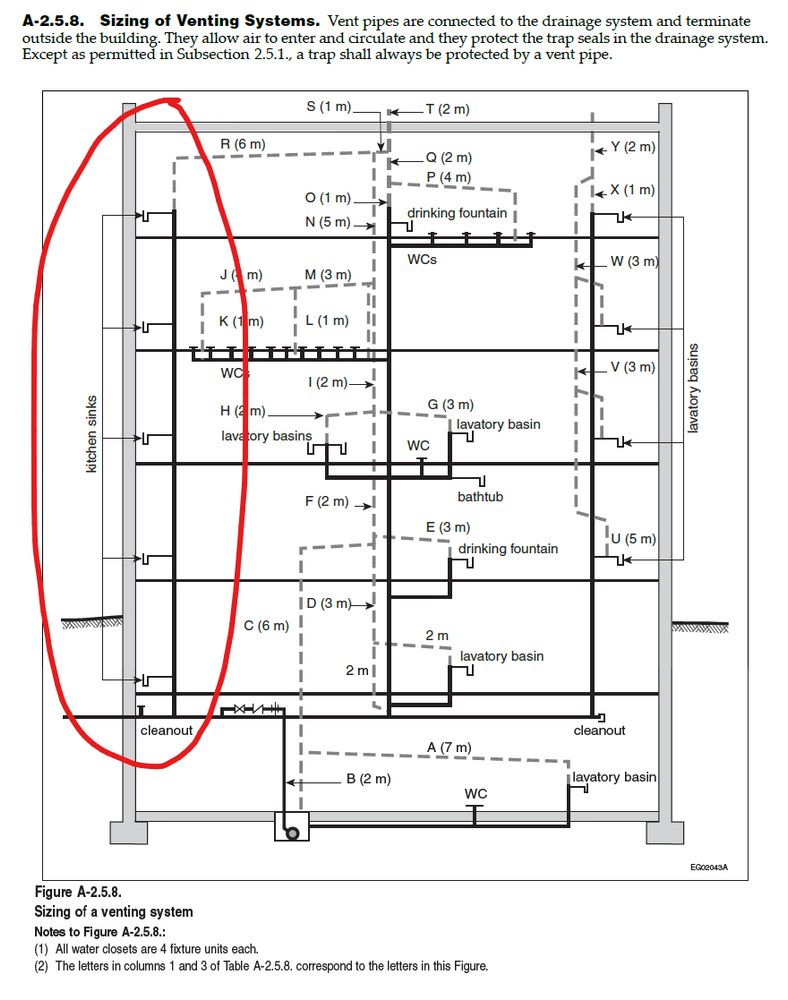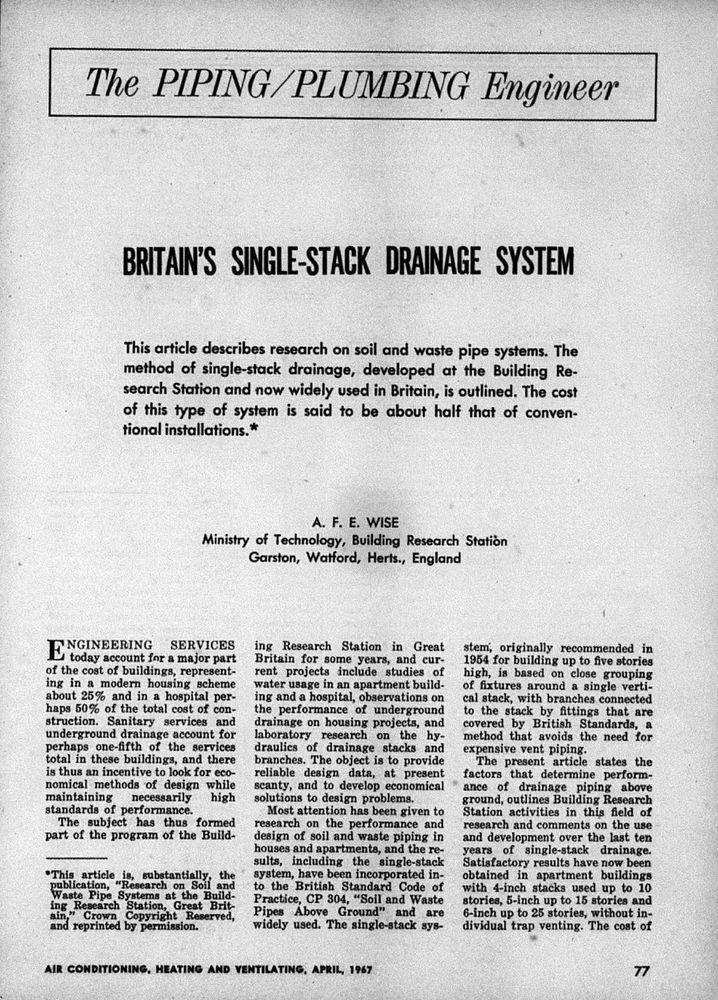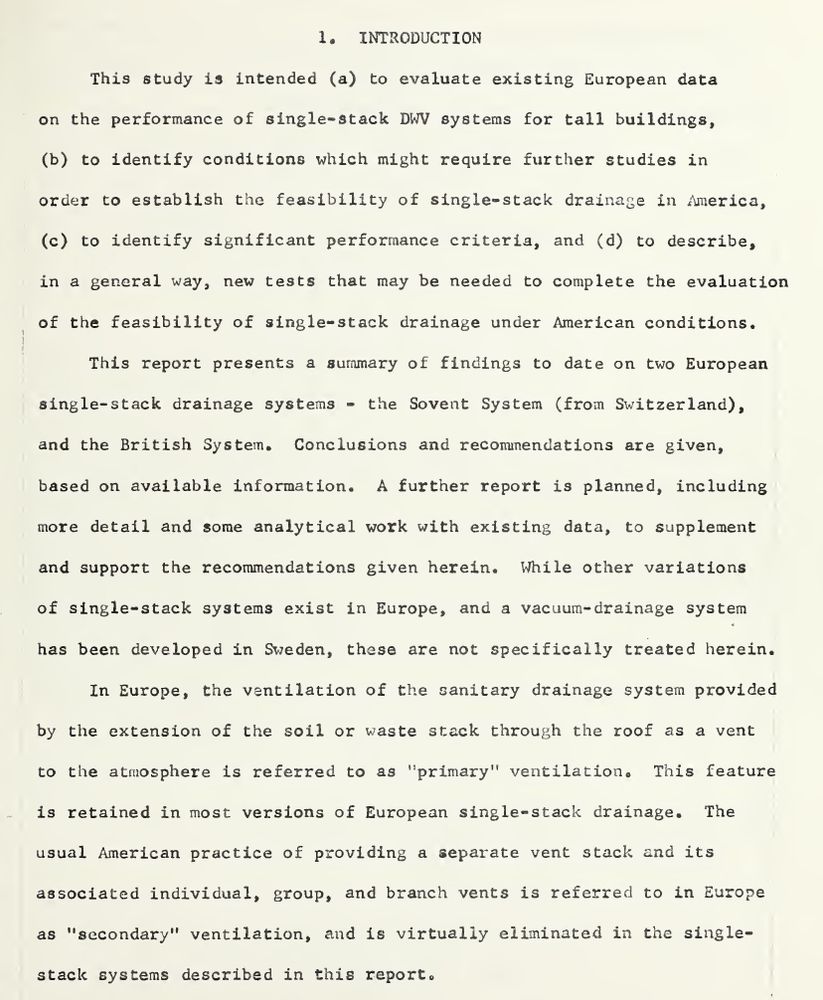
![913-WASTE STACK VENT
913.1 Waste stack vent permitted. A waste stack shall be considered to be a vent for all of the fixtures discharging to the stack where installed in accordance with the requirements of this section.
C A waste stack vent uses the waste stack as the vent for fixtures other than urinals and water closets. The principles of use are based on some of the original research that was done in development of the first plumbing codes. The system has been identified by a variety of names, including vertical wet vent, Philadelphia single-stack and multifloor stack venting. Note that due to the oversized design of a waste stack vent system, a vent stack is not required and thus, a relief vent is not required (see Section 904.2, Exception).
913.2 Stack installation. The waste stack shall be vertical, and both horizontal and vertical offsets shall be prohibited between the lowest fixture drain connection and the highest fixture drain connection. Fixture drains shall connect separately to the waste stack.
The stack shall not receive the discharge of water closets or urinals.
C Because the drainage stack serves as the vent, there are certain limitations on the design to prevent pressures in the system from exceeding plus or minus 1 inch of water column (249 Pa). The system is identified as a waste stack vent because it prohibits the connection of water closets and urinals. Only waste may discharge to the stack.
Water closets and some urinals have a surging discharge that results in too great a pressure fluctuation in the system.
The system can serve sinks, lavatories, bathtubs, bidets, showers, floor drains, drinking fountains and standpipes.
To preserve the desirable annular flow in the [text overrun]](https://cdn.bsky.app/img/feed_thumbnail/plain/did:plc:zrfppf44vjnvtplygmvbk5we/bafkreidrxuongawimu7pb75p2nxzfnaddbvn52o5jju5mdcnsyxjc3d4aq@jpeg)





























Works just like the mobile app.
Install this app on your iPhone: tap the share button and then Add to Home Screen.
Tap the Share button
in Safari's toolbar
Select "Add to Home Screen"
from the menu
Tap "Add"
The app will appear on your home screen

![913-WASTE STACK VENT
913.1 Waste stack vent permitted. A waste stack shall be considered to be a vent for all of the fixtures discharging to the stack where installed in accordance with the requirements of this section.
C A waste stack vent uses the waste stack as the vent for fixtures other than urinals and water closets. The principles of use are based on some of the original research that was done in development of the first plumbing codes. The system has been identified by a variety of names, including vertical wet vent, Philadelphia single-stack and multifloor stack venting. Note that due to the oversized design of a waste stack vent system, a vent stack is not required and thus, a relief vent is not required (see Section 904.2, Exception).
913.2 Stack installation. The waste stack shall be vertical, and both horizontal and vertical offsets shall be prohibited between the lowest fixture drain connection and the highest fixture drain connection. Fixture drains shall connect separately to the waste stack.
The stack shall not receive the discharge of water closets or urinals.
C Because the drainage stack serves as the vent, there are certain limitations on the design to prevent pressures in the system from exceeding plus or minus 1 inch of water column (249 Pa). The system is identified as a waste stack vent because it prohibits the connection of water closets and urinals. Only waste may discharge to the stack.
Water closets and some urinals have a surging discharge that results in too great a pressure fluctuation in the system.
The system can serve sinks, lavatories, bathtubs, bidets, showers, floor drains, drinking fountains and standpipes.
To preserve the desirable annular flow in the [text overrun]](https://cdn.bsky.app/img/feed_thumbnail/plain/did:plc:zrfppf44vjnvtplygmvbk5we/bafkreidrxuongawimu7pb75p2nxzfnaddbvn52o5jju5mdcnsyxjc3d4aq@jpeg)































Enter your Bluesky handle and app password to unlock posting, likes, and your Following feed.
Need an app password? Open Bluesky, go to Settings > App passwords, and create a new one.


Sign in with your Bluesky account to unlock posting, likes, and your Following feed.